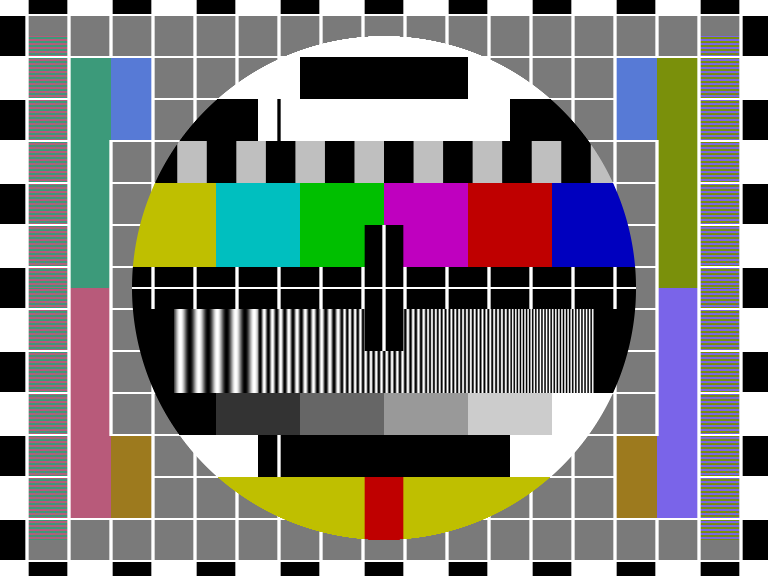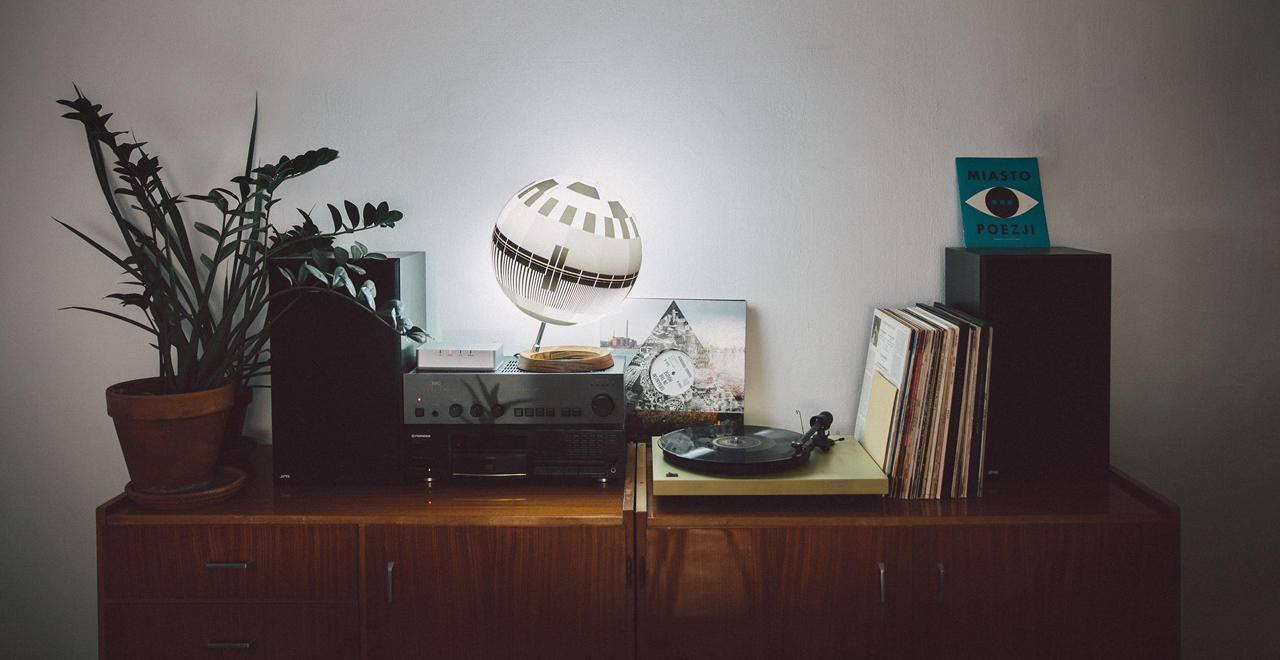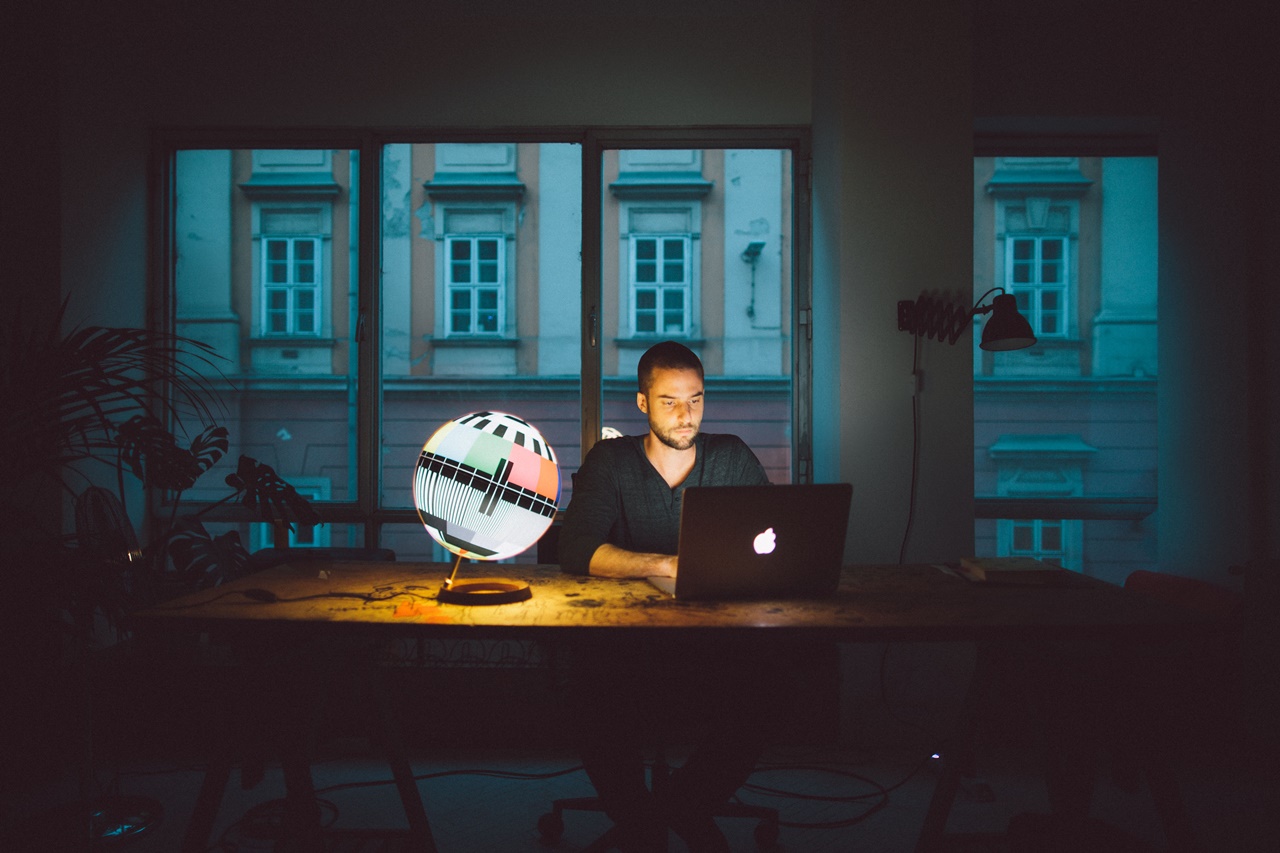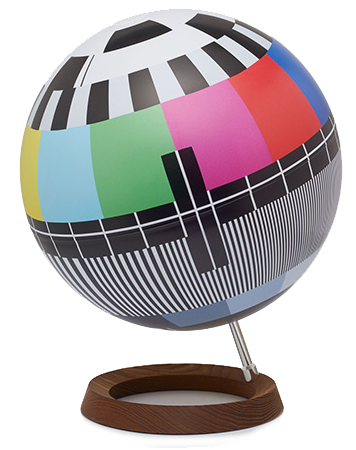
MONO LAMP
Memory of Design ~ Interview at Simon Forgacs
“I’ve designed a lamp inspired by the world famous television test card. A lamp that symbolizes a whole era of analog television history in a unique way and also cherish so many sweet memories.”
In this way, Simon Forgacs, Hungarian UX designer introduced the crowdfunding company for his Mono Lamp. Manufactured in Italy, the lamp structure resumes the classic globe which countries/continents/landscapes are rounds, triangles, lines and the colors of the almost disappeared test card Philips PM5544, the most famous test card of the old cathode-ray tube TV that appeared in early 70-s and remained in the social imaginary over the next few decades.
Furthermore monochrome version is available, this lamp captivates immediately with its personality and it is instantly recognisable in awakening the curious reflections about one of the leading/distinguished role of the product design: the preservation of memory. Mono Lamp veritably belongs to the products that well endowed with the capacity to reincarnate in the new forms the articles and instruments diverse of their initial using, reacquainting the hidden beauty filled in memories and timeless nostalgia.
“I remember as a child I was watching this for hours, [...] it fascinated me how cool it looks. The strange geometrical shapes and vivid colors and the fact that it lived inside the same box where Star Wars and Back to the Future, so it’s just didn’t made any sense to me but I loved it.”
I reached Simon to reveal something more about his artistic and professional background, his taste when it comes to design and, evidently, to explore the path that led to implement Mono Lamp.
Hi Simon, I read from your website that you’re working on UX/UI Design field and that Monolamp is a side project with which you could “sail away from app designs to the realm of physical objects”. How did the idea of reproducing the famous Philips test card come out and why exactly in a lamp?

Philips PM5544 Television Test Pattern
There where many test cards in the past but probably the most
emblematic - and consequently the most known - was the
PM5544 designed by engineer called Finn Hendil in
the Philips TV laboratory in Copenhagen. Testcards inspired
Mono Lamp in general, but it resembles the PM5544’s design the
most.
I am a UX Designer and Entrepreneur by trade. I’ve spent
most of the past ten years of my life designing digital products,
but I was always interested in hardware and physical object
design. When I quitted my last job as head of design at
SaaS startup in Boston I wanted to take some time off from
the digital world and to do something fun, outside of the box,
where I can learn a ton of new things. At this time the idea of
Mono Lamp was already with me for a while. A few years back I’ve
stumbled upon an image of a test card and suddenly the image
popped from 2 to 3 dimensions in my vision and never went back.
That was my “aha” moment. ;)
Then came the desire to bring it out of the screen to the real
world and somehow keep it lit. I guess that’s how I’ve come up
with the lamp idea. But as always I learn it again and again:
ideas are the easy, execution is hard. I doubt that there is
anything special in my idea and I bet some people had very similar
or even the same idea before me, but the only difference is that
they couldn’t or didn’t want to make it a reality. After all, this
is a very niche design product with many feasibility risks, huge
upfront investment and with a small and declining market size - as
there is no Generation X resupply. So I would instead say
that the idea found me and not the other way around, as it needed
someone who’s motivation isn’t financial gains.

The first time I’ve seen a Monolamp’s picture it has been love at
first sight! I catched myself overwhelmed by a whole series of
memories related to my childhood in the 90s; I started thinking
about that kind of beauty often inherent some simple tools and how
this beauty is able to resist over time, even when the instrument
itself has become obsolete and all its technical usefulness has
been lost.
You took a test screen that anyone was watching TV in the 80s
& 90s remembers and you used it in a completely different
context - even if in some way it was already related to light.
Could you talk a bit about the most emotional aspects that have
been part of the creative process around your product?
It has to do something with the way our brain is wired as humans
and how our memories work. A smell, a sound, an image can all
trigger a whole cluster of memories from a different period of our
life. For me personally, every time I look at a testcard a storm
of feelings and memories came to me from my childhood. For example
I still remember as a 5 years old I was staring deeply into the TV
screen for long minutes, trying to understand the meaning of the
test card. I had no idea what was it but I felt it’s very
important, and it hides some important knowledge about life (which
it might does). I’m sure that this is true for many of us and
especially for who bought a lamp.
Switching contexts back and forth between digital and the analogue
world is the area that always interested me, and a few years back,
when the idea of the lamp was born I was also motivated by the
desire to bring this icon back to my life as it was already frayed
from the TV: Mono Lamp is kind of a present for my generation, the
Generation X, with whom I share the most memories, feel the
closest and who I understands the most.

Italy is the country where you chose to produce Monolamp, would you like to tell us how you got to this choice, starting from Hungary up to the nation of Achille Castiglioni and Sergio Mazza?
Mentioning me in one sentence with Achille Castiglioni and
Sergio Mazza is way too generous that I don’t deserve and
therefore humbly decline, simply because I’m a charlatan compare
to them in product design.
There is a simple reason behind why I’ve chosen Italy: there is an
almost 70 years old company here called Tecnodidattica who
not only had the right technology and experience for my specific
goals but also a fragile balance between three very important
variables: product-quality, -cost, and -scalability. I’ve spent
over a year experimenting with different technologies (4
different), materials (3 different) and production lines (on 2
continents and 5 different countries) to finally get – in my view
– the right balance between them and here, in Italy is where I
finally did. Without Tecnodidattica kind help this project would
have never been realised.

In the official presentation you refer to “the essence of TV for the generation grew up in the 80s & 90s”. The theme of nostalgia is today more central than ever in a multitude of disciplines (cinema, TV series, music, design) with results ranging from excellent reinterpretations and good aesthetic appropriations to revival operations with purely commercial purposes. What do you think about it? Are we living in an era with a perpetually past-oriented gaze?

Fritz Lang - Metropolis (1927)
I think nostalgia was always part of human existence - and personally, it’s essential to me. It looks like to me a bit that we (humans) have always lived and live in some level of - as you’ve elegantly put it: past-oriented gaze, only the content changes from generation to generation. Once mine - the Generation X - disappears it will take the meaning of certain things with it. Indiana Jones, Back to the Future, Terminator 2, Testcards, Mono Lamps (etc) will make little or no sense for future generations. Similar way for example as the fantastic sci-fi movie from 1927 Metropolis means to my generation today: it is a must see, it is essential, but it’s more part of our cultural history as part of our daily life compared to Star Wars or Aliens. I make too many movie references, I know. :)
Monolamp is your first work as a product designer, and the fact that you hit the mark on the first shot makes us think that over your experience in User Interface you have a strong passion for design in a wider sense. Can you tell us about your tastes, your favorite designers and the objects that have always been part of your imaginary? Please, take all the space you want for this question as well :)

I really appreciate your kind words but the presumed success of
Mono Lamp stands heavily on shoulders of other designers: Mono
Lamp is inspired from an existing design, namely TV testcards.
Also the beautiful wooden base was designed over 12 years ago by
Claus Jensen & Henrik Holbaek from
Tools Design and used here – and for many other globes
before – with their kind approval. I only happen to be the one who
connected the dots where no one else felt important enough to do
so. Which easily be true and actually not that important. It was
probably a selfish act on my part to do this project as I
personally really wanted to have a lamp like this. It’s in my
bedroom till this day and get lit every night! :)
I believe that as in most thing in life perseverance and laser
focus on your goal and luck is all important ingredients of
success. That’s why it’s painful to confess that - as most
designers and humans in general - I’m interested in way too many
things that I have time to explore or play with. Mono Lamp was a
bit of a “payback time” to the kid living in me, a way to
show to myself that a sometimes I can do whatever I want. Even
something that can seen as a complete U turn (even just for a
brief moment) on the professional path I walk on.
My favorite designers…. I have way too many! Next question. :)

As conclusion we would like to listen to some advices you feel like to give to young designers today struggling with the creation of their first works, how to approach the phase of transforming their projects into real products, etc. Thank you for taking the time to answer on the questions, Simon! :)
Tough question! I can’t escape the fear that my answer no matter
how I fraze it will be short and sound like commonplace but this
is what I can say today - with the caveat that what might have
worked for me might not work for others and one of the more
important thing is to listen to everything but follow your own
instinct.
Try things, risk as much as you reasonably can (maybe a little
more) and don’t be afraid of failure. You don’t need to like or
embrace failure, just acknowledge that it is an important part of
success. Be persevere and as focused as you can be. A successful
person in general just tried a few times more than others (read
about Jack Ma). Reduce the noise around you and focus only
to the advise of people important to your path. Try to be patient
with yourself, a work-life balance can help. Eat well, exercise
regularly, walk in the nature, take good care of your loved ones
and yourself and read
Jordan B. Petersons 12 Rules for Life!
OFFICIAL SITE:
https://monolamp.hu/en/
CROWDFUNDING:
https://indiegogo.com/projects/mono-lamp-a-design-lamp-capturing-tv-history


